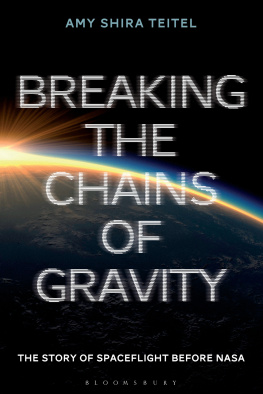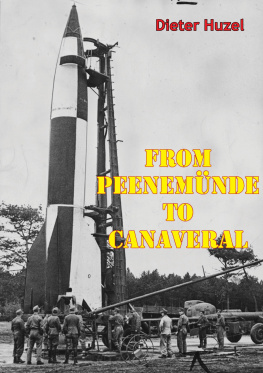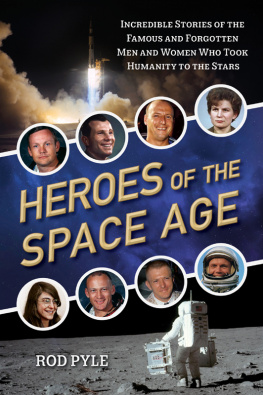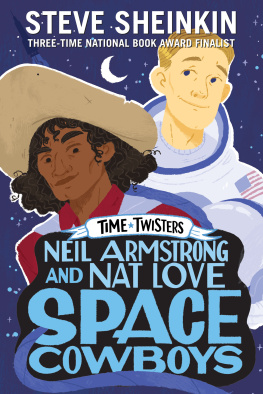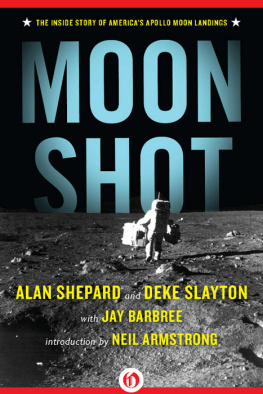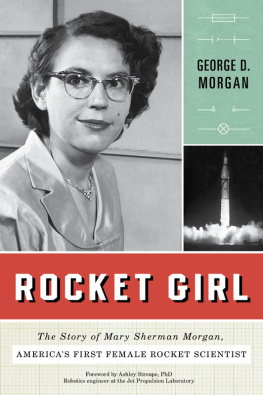A NOTE ON THE AUTHOR
Amy Shira Teitel is a lifelong space-history nerd who has turned her schoolgirl fascination with the Apollo missions into a career researching the minutiae of spaceflights history.
Amy started writing for the public with her blog, Vintage Space. She has also written for a number of other online and print publications including Discovery News Space, Al-Jazeera, the Guardian and Universe Today. She runs a thriving YouTube channel (also called Vintage Space), and has appeared on the Discovery channel, the Military channel, SyFy, and the Science channel, and she is a host on DNews , Discovery Channels online daily news show. Amy was also an embedded journalist on the New Horizons team, bringing the excitement of humanitys first mission to Pluto to the space-loving public.
Also available in the Bloomsbury Sigma series:
Sex on Earth by Jules Howard
p53: The Gene that Cracked the Cancer Code by Sue Armstrong
Atoms Under the Floorboards by Chris Woodford
Spirals in Time by Helen Scales
Chilled by Tom Jackson
A is for Arsenic by Kathryn Harkup
Suspicious Minds by Rob Brotherton
Herding Hemingways Cats by Kat Arney
Electronic Dreams by Tom Lean
Sorting the Beef from the Bull by Richard Evershed and Nicola Temple
Death on Earth by Jules Howard
The Tyrannosaur Chronicles by David Hone
Soccermatics by David Sumpter
Big Data by Timandra Harkness
Goldilocks and the Water Bears by Louisa Preston
Science and the City by Laurie Winkless
Bring Back the King by Helen Pilcher
Furry Logic by Matin Durrani and Liz Kalaugher
Built on Bones by Brenna Hassett
My European Family by Karin Bojs
4th Rock from the Sun by Nicky Jenner
Patient H69 by Vanessa Potter
Catching Breath by Kathryn Lougheed
PIG/PORK by Pa Spry-Marqus
The Planet Factory by Elizabeth Tasker
Immune by Catherine Carver
Wonders Beyond Numbers by Johnny Ball
I, Mammal by Liam Drew
Reinventing the Wheel by Bronwen and Francis Percival
For spaceflights pioneers who continue to inspire,
and for Mark who believed in me at the start
BREAKING THE CHAINS OF GRAVITY
THE STORY OF SPACEFLIGHT BEFORE NASA
Amy Shira Teitel

Contents
Popular retellings of the National Aeronautics and Space Administrations history typically follow the same narrative: In 1961, President John F. Kennedy pledged the nation would land a man on the Moon by the end of the decade and return him safely to the Earth. In July of 1969, Neil Armstrong took one small step on the Sea of Tranquillity, fulfilling the fallen presidents dream and completing a technologically daunting task in the name of restoring Americas national prestige. It was, by all accounts, a remarkable achievement given spaceflights embryonic state in the 1960s and the short time frame. The story becomes even more incredible in light of the fact that NASA was just three years old and hadnt yet put a man in orbit when Kennedy promised America the Moon. Though common, this version of the story creates the illusion that NASA invented a lunar landing program in response to a presidential decree.
NASA wasnt created in a vacuum and suddenly tasked with the Moon landing. The agency might have been incepted in 1958, but it was assembled from preexisting parts, drawing off decades of research in rocketry, human tolerances, hypersonic flight, and the bureaucracy needed to oversee a major undertaking like a lunar landing program. NASA has technological and bureaucratic roots stretching back decades before it formally opened for business that made the Apollo program possible, and these roots are what this book is about.
The incredible rockets that launched Americas first astronauts reached the nation by way of German engineers imported after the Second World War and employed by the U.S. military. The knowledge of human survival in space came from early air force programs, some done with primates and some with humans. Knowledge of how a vehicle could return safely from orbit was largely the product of the National Advisory Committee for Aeronautics, the agency that was also versed in bridging the gap between military and civilian partners in cutting-edge aeronautics programs.
But it must be said that this book only tells part of the story. Almost every rocket, aircraft, person, organization, and research laboratory in this book merits a work dedicated to its history. In fact, most of them do have dedicated volumes. In simplifying the story to bring it to a broader audience, I decided to focus on certain people and follow certain narratives to the exclusion of some notable figures like American engineer Robert Goddard and Russian scientist Konstantin Tsiolkovsky, two fathers of rocketry whose contributions to the field were invaluable. The complete, unedited story would be a tome that only die-hard space fans would have the patience to sift through. Spaceflight is part of our shared human history and shouldnt be an opus accessible only to initiates. It should be available to everyone interested in exploring this rich history.
Among other decisions I made in writing this book was the decision to use male pronouns. With a handful of exceptions, everyone working in aviation and aeronautics between 1930 and 1958 was male, and most forward thinkers assumed that the first person in space would be a man. It is a thought process indicative of the era. I also chose to keep center names and dollar amounts consistent with the time frame of the book. Names are not reflective of current monikers, and values have not been adjusted for inflation.
My hope is that this book opens up NASAs prehistory to those who might not realize that Americas national space agency has such a fascinating backstory, and that it inspires a few to dig into this history a little further. Humanitys exploration of space is wonderful. Having a deeper understanding of how it all started is not only interesting, having a sense of the context makes everything we have achieved in the last half century of space exploration that much more incredible.
On May 17, 1930, dusk fell just before nine oclock at the end of a warm, clear Saturday in Britz, Berlin, but Max Valier showed no signs of leaving his workbench for an evening of leisure. He remained in his seat, focused on a simple combustion chamber bolted to the table in front of him. It was a simple setup. At the center was a combustion chamber, a simple steel tube with an upward-facing exhaust nozzle. On the other end were a series of small bore holes through which the fuel and oxidizer were introduced. The whole apparatus was set up on a grocery scale. His assistants Arthur Rudolph and Walter Riedel sat some distance away at two tanks, one of kerosene mixed with water and the other of liquid oxygen. The two men manually opened the valves as Valier dictated, sending the fuel and oxidizer into the combustion chamber where they mixed. Once the combustion chamber was adequately pressurized, Valier lit the mixture with a blowtorch. As the jet of flaming gases roared upward from the combustion chamber, directed by the nozzle, the resulting reaction was a downward force onto the scale. While the engine burned, Valier added weights to the other side of the scale until it was properly balanced, giving him a crude measure of the engines efficiency.
That day, Valier had made two successful tests with the same setup. Two good burns in the combustion chamber had yielded good data. A third test had failed, the accompanying jolting motions deforming the test hardware at the same time. At that point Riedel had pushed for the skeleton crew to end their day and start fresh the next day, but Valiers enthusiasm had been indomitable. He was so encouraged by the afternoons successes that he pushed for one final test to end the day on a high note. The combustion chamber was reassembled, the fuel and liquid oxygen tanks were hooked up.

